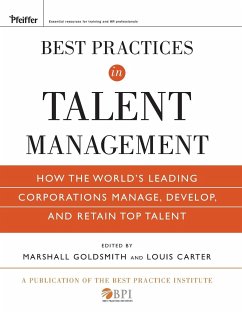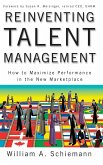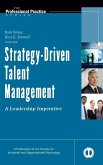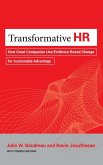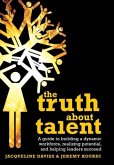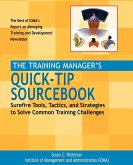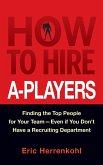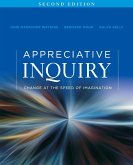- Gebundenes Buch
- Merkliste
- Auf die Merkliste
- Bewerten Bewerten
- Teilen
- Produkt teilen
- Produkterinnerung
- Produkterinnerung
Comprehensive in scope, this book features more than 15 case studies and dozens of competency models, tools, instruments, and training material from the world's best global talent management systems and campaigns that show how thy successfully implemented and maintained talent management programs. Each case study includes tools, templates, competency models, guidelines, and training materials that can easily transfer to the real-world work of HR professionals. In addition the book is written by leading-edge contributions from the top thinkers in the field.
Andere Kunden interessierten sich auch für
![Reinventing Talent Management Reinventing Talent Management]() William A SchiemannReinventing Talent Management34,99 €
William A SchiemannReinventing Talent Management34,99 €![Strategy-Driven Talent Management Strategy-Driven Talent Management]() Rob Silzer / Ben E. DowellStrategy-Driven Talent Management110,99 €
Rob Silzer / Ben E. DowellStrategy-Driven Talent Management110,99 €![Transformative HR Transformative HR]() John W BoudreauTransformative HR30,99 €
John W BoudreauTransformative HR30,99 €![The Truth about Talent The Truth about Talent]() Jacqueline DaviesThe Truth about Talent53,99 €
Jacqueline DaviesThe Truth about Talent53,99 €![The Training Manager's Quick-Tip Sourcebook The Training Manager's Quick-Tip Sourcebook]() Institute of Management and Administration (IOMA)The Training Manager's Quick-Tip Sourcebook69,99 €
Institute of Management and Administration (IOMA)The Training Manager's Quick-Tip Sourcebook69,99 €![How to Hire A-Players How to Hire A-Players]() Eric HerrenkohlHow to Hire A-Players23,99 €
Eric HerrenkohlHow to Hire A-Players23,99 €![Appreciative Inquiry Appreciative Inquiry]() Jane Magruder WatkinsAppreciative Inquiry76,99 €
Jane Magruder WatkinsAppreciative Inquiry76,99 €-
-
-
Comprehensive in scope, this book features more than 15 case studies and dozens of competency models, tools, instruments, and training material from the world's best global talent management systems and campaigns that show how thy successfully implemented and maintained talent management programs. Each case study includes tools, templates, competency models, guidelines, and training materials that can easily transfer to the real-world work of HR professionals. In addition the book is written by leading-edge contributions from the top thinkers in the field.
Hinweis: Dieser Artikel kann nur an eine deutsche Lieferadresse ausgeliefert werden.
Hinweis: Dieser Artikel kann nur an eine deutsche Lieferadresse ausgeliefert werden.
Produktdetails
- Produktdetails
- Verlag: John Wiley & Sons / Wiley
- Seitenzahl: 336
- Erscheinungstermin: 1. Dezember 2009
- Englisch
- Abmessung: 241mm x 196mm x 23mm
- Gewicht: 825g
- ISBN-13: 9780470499610
- ISBN-10: 0470499613
- Artikelnr.: 27368359
- Herstellerkennzeichnung
- Libri GmbH
- Europaallee 1
- 36244 Bad Hersfeld
- gpsr@libri.de
- Verlag: John Wiley & Sons / Wiley
- Seitenzahl: 336
- Erscheinungstermin: 1. Dezember 2009
- Englisch
- Abmessung: 241mm x 196mm x 23mm
- Gewicht: 825g
- ISBN-13: 9780470499610
- ISBN-10: 0470499613
- Artikelnr.: 27368359
- Herstellerkennzeichnung
- Libri GmbH
- Europaallee 1
- 36244 Bad Hersfeld
- gpsr@libri.de
THE AUTHORS MARSHALL GOLDSMITH, PH.D., is one of a select few advisors who have been asked to work with over 120 major CEOs and their management teams. A prolific author, his book What Got You Here Won't Get You There was ranked as the #1 best-selling business book by the The New York Times and The Wall Street Journal. For ten years, he served as a member of the Board of the Peter Drucker Foundation. LOUIS CARTER is the Founder and CEO of the Best Practice Institute, and a world-renown leadership and organization change advisor. He is the author of over nine books on best practices including Change Champion's Fieldguide and Best Practices in Leadership Development and Change.
Introduction, by Louis Carter xiii
Acknowledgments xxvii
How to Use This Book xxix
Chapter One: Avon Products, Inc. 1
By Marc Effron
Introduction 2
A Success-Driven Challenge 2
The Turnaround 3
The Talent Challenge 3
Execute on the "What," Differentiate with "How" 4
From Opaque to Transparent 5
From Complex to Simple 7
From Egalitarian to Differentiated 10
From Episodic to Disciplined 11
From Emotional to Factual 12
From Meaningless to Consequential 13
The Results of a Talent Turnaround 14
Measuring the Talent Turnaround's Success 15
Chapter Two: Bank of America 17
By Brian Fishel and Jay Conger
Introduction 18
Leadership Development Activities for Executive Leaders 21
Lessons for Designing On-Boarding for Executive Leaders 32
Chapter Three: Corning Incorporated 36
By Richard A. O'leary, Gary Jusela, and Heath N. Topper
Introduction 37
The Business Case for the Accelerated Development of Corning Program
Managers 40
The Design Flow: Two Weeks of Experiential Learning with an Interim Period
of Coaching and Mentoring 48
Outcomes and Next Steps for Growing the Talent Pipeline of Program Leaders
56
Next Steps 57
Chapter Four: Customer and Enterprise Services (CES) Division 60
By Michael Schecter, John Parker, and Judy Zaucha
Business Background and Challenges 61
The Roots of the CES Transformation: Leadership and Process 62
Diagnosing and Designing the Whole System Transformation: The Leadership
Alignment Event 68
Implementing the Whole System Transformation: The Waves 71
Supporting and Reinforcing the Whole System Transformation 77
Evaluation of the CES Whole System Transformation 82
Chapter Five: Ecolab, Inc. 84
By Robert C. Barnett, Michael L. Meyer, Sarah J. Murphy, and Susan M.
Metcalf
Introduction 85
Company Background 85
Ecolab's 2002-2007 Strategic Plan 85
Culture is Critical 87
Ecolab's Talent Management Philosophy 88
The Ecolab Talent Pipeline 90
The Importance of Individual Development 90
Introducing the Talent Pipeline Model at Ecolab 95
Supporting Successful Implementation 95
Keeping the Pipeline Full 98
Results 100
Conclusion 101
Chapter Six: GE Money Americas 103
By Tammy Grisham and D. Zachary Misko
Introduction 104
Company Background and Environment 104
The Challenge and Approach 105
The Technology 106
Strategy for Sourcing 108
LEAN Methodologies 111
Expansion 113
Conclusion 114
Chapter Seven: Internal Revenue Service 115
By Susan Clayton, Victoria Baugh, And Mathew J. Ferrero
Introduction 116
Company Background and Current Leadership Environment 116
The 21st Century IRS 118
Leadership Succession Planning-The Challenges 121
LSR Website and Infrastructure 126
Results 128
Indicators of Success 131
Evaluation 132
Next Steps 133
Conclusion 134
Chapter Eight: Kaiser Permanente Colorado Region 136
By Margaret Turner
Introduction 137
Design 140
Process 142
Implementation 150
Support and Reinforce 152
Evaluation 153
Next Steps 153
Conclusion 154
Chapter Nine: McDonald's 155
By James Intagliata and Neal Kulick
Context for Global Talent Management Initiatives 156
Evolution of the Talent Management System: Key Initiatives and Enhancements
159
Overall Summary 175
Chapter Ten: Microsoft Corporation 177
By Shannon Wallis, Brian O. Underhill, and Carter Mcnamara
Introduction 178
What Led Microsoft SMSG to Make the Change 179
Expo Leaders Building Leaders-The New High-Potential Development Experience
179
The Process of Redesigning the High-Potential Development Experience 189
Coaching as a Primary Development Component for HiPo Development in SMSG
191
Learning Circles as a Primary Development Component for HiPo Development in
SMSG 199
Conclusion 206
Chapter Eleven: Murray & Roberts Limited 208
By Zelia Soares
Introduction 209
Design and Alignment 214
Implementation 220
Evaluation 223
Summary 224
Chapter Twelve: Porter Novelli 225
By Greg Waldron
Introduction 226
Program Implementation 231
Performance Management System Development 236
Evaluation 239
Chapter Thirteen: Southern Company 241
By Jim Greene
Introduction 242
Background 242
Initial Improvements 243
The Leadership Action Council 246
Competency Model 247
Leadership Assessment 248
Succession Planning 249
Leadership Database 254
Development Activities 254
Evaluation and Lessons Learned 256
Chapter Fourteen: Whirlpool Corporation 258
By Kristen Weirick
Introduction 259
The Business Challenge 259
Design and Approach 260
Evaluation 265
Next Steps 266
Summary 269
Conclusion 271
Epilogue, by William J. Rothwell 288
Index 295
About Best Practice Institute 303
About the Editors 305
Acknowledgments xxvii
How to Use This Book xxix
Chapter One: Avon Products, Inc. 1
By Marc Effron
Introduction 2
A Success-Driven Challenge 2
The Turnaround 3
The Talent Challenge 3
Execute on the "What," Differentiate with "How" 4
From Opaque to Transparent 5
From Complex to Simple 7
From Egalitarian to Differentiated 10
From Episodic to Disciplined 11
From Emotional to Factual 12
From Meaningless to Consequential 13
The Results of a Talent Turnaround 14
Measuring the Talent Turnaround's Success 15
Chapter Two: Bank of America 17
By Brian Fishel and Jay Conger
Introduction 18
Leadership Development Activities for Executive Leaders 21
Lessons for Designing On-Boarding for Executive Leaders 32
Chapter Three: Corning Incorporated 36
By Richard A. O'leary, Gary Jusela, and Heath N. Topper
Introduction 37
The Business Case for the Accelerated Development of Corning Program
Managers 40
The Design Flow: Two Weeks of Experiential Learning with an Interim Period
of Coaching and Mentoring 48
Outcomes and Next Steps for Growing the Talent Pipeline of Program Leaders
56
Next Steps 57
Chapter Four: Customer and Enterprise Services (CES) Division 60
By Michael Schecter, John Parker, and Judy Zaucha
Business Background and Challenges 61
The Roots of the CES Transformation: Leadership and Process 62
Diagnosing and Designing the Whole System Transformation: The Leadership
Alignment Event 68
Implementing the Whole System Transformation: The Waves 71
Supporting and Reinforcing the Whole System Transformation 77
Evaluation of the CES Whole System Transformation 82
Chapter Five: Ecolab, Inc. 84
By Robert C. Barnett, Michael L. Meyer, Sarah J. Murphy, and Susan M.
Metcalf
Introduction 85
Company Background 85
Ecolab's 2002-2007 Strategic Plan 85
Culture is Critical 87
Ecolab's Talent Management Philosophy 88
The Ecolab Talent Pipeline 90
The Importance of Individual Development 90
Introducing the Talent Pipeline Model at Ecolab 95
Supporting Successful Implementation 95
Keeping the Pipeline Full 98
Results 100
Conclusion 101
Chapter Six: GE Money Americas 103
By Tammy Grisham and D. Zachary Misko
Introduction 104
Company Background and Environment 104
The Challenge and Approach 105
The Technology 106
Strategy for Sourcing 108
LEAN Methodologies 111
Expansion 113
Conclusion 114
Chapter Seven: Internal Revenue Service 115
By Susan Clayton, Victoria Baugh, And Mathew J. Ferrero
Introduction 116
Company Background and Current Leadership Environment 116
The 21st Century IRS 118
Leadership Succession Planning-The Challenges 121
LSR Website and Infrastructure 126
Results 128
Indicators of Success 131
Evaluation 132
Next Steps 133
Conclusion 134
Chapter Eight: Kaiser Permanente Colorado Region 136
By Margaret Turner
Introduction 137
Design 140
Process 142
Implementation 150
Support and Reinforce 152
Evaluation 153
Next Steps 153
Conclusion 154
Chapter Nine: McDonald's 155
By James Intagliata and Neal Kulick
Context for Global Talent Management Initiatives 156
Evolution of the Talent Management System: Key Initiatives and Enhancements
159
Overall Summary 175
Chapter Ten: Microsoft Corporation 177
By Shannon Wallis, Brian O. Underhill, and Carter Mcnamara
Introduction 178
What Led Microsoft SMSG to Make the Change 179
Expo Leaders Building Leaders-The New High-Potential Development Experience
179
The Process of Redesigning the High-Potential Development Experience 189
Coaching as a Primary Development Component for HiPo Development in SMSG
191
Learning Circles as a Primary Development Component for HiPo Development in
SMSG 199
Conclusion 206
Chapter Eleven: Murray & Roberts Limited 208
By Zelia Soares
Introduction 209
Design and Alignment 214
Implementation 220
Evaluation 223
Summary 224
Chapter Twelve: Porter Novelli 225
By Greg Waldron
Introduction 226
Program Implementation 231
Performance Management System Development 236
Evaluation 239
Chapter Thirteen: Southern Company 241
By Jim Greene
Introduction 242
Background 242
Initial Improvements 243
The Leadership Action Council 246
Competency Model 247
Leadership Assessment 248
Succession Planning 249
Leadership Database 254
Development Activities 254
Evaluation and Lessons Learned 256
Chapter Fourteen: Whirlpool Corporation 258
By Kristen Weirick
Introduction 259
The Business Challenge 259
Design and Approach 260
Evaluation 265
Next Steps 266
Summary 269
Conclusion 271
Epilogue, by William J. Rothwell 288
Index 295
About Best Practice Institute 303
About the Editors 305
Introduction, by Louis Carter xiii
Acknowledgments xxvii
How to Use This Book xxix
Chapter One: Avon Products, Inc. 1
By Marc Effron
Introduction 2
A Success-Driven Challenge 2
The Turnaround 3
The Talent Challenge 3
Execute on the "What," Differentiate with "How" 4
From Opaque to Transparent 5
From Complex to Simple 7
From Egalitarian to Differentiated 10
From Episodic to Disciplined 11
From Emotional to Factual 12
From Meaningless to Consequential 13
The Results of a Talent Turnaround 14
Measuring the Talent Turnaround's Success 15
Chapter Two: Bank of America 17
By Brian Fishel and Jay Conger
Introduction 18
Leadership Development Activities for Executive Leaders 21
Lessons for Designing On-Boarding for Executive Leaders 32
Chapter Three: Corning Incorporated 36
By Richard A. O'leary, Gary Jusela, and Heath N. Topper
Introduction 37
The Business Case for the Accelerated Development of Corning Program
Managers 40
The Design Flow: Two Weeks of Experiential Learning with an Interim Period
of Coaching and Mentoring 48
Outcomes and Next Steps for Growing the Talent Pipeline of Program Leaders
56
Next Steps 57
Chapter Four: Customer and Enterprise Services (CES) Division 60
By Michael Schecter, John Parker, and Judy Zaucha
Business Background and Challenges 61
The Roots of the CES Transformation: Leadership and Process 62
Diagnosing and Designing the Whole System Transformation: The Leadership
Alignment Event 68
Implementing the Whole System Transformation: The Waves 71
Supporting and Reinforcing the Whole System Transformation 77
Evaluation of the CES Whole System Transformation 82
Chapter Five: Ecolab, Inc. 84
By Robert C. Barnett, Michael L. Meyer, Sarah J. Murphy, and Susan M.
Metcalf
Introduction 85
Company Background 85
Ecolab's 2002-2007 Strategic Plan 85
Culture is Critical 87
Ecolab's Talent Management Philosophy 88
The Ecolab Talent Pipeline 90
The Importance of Individual Development 90
Introducing the Talent Pipeline Model at Ecolab 95
Supporting Successful Implementation 95
Keeping the Pipeline Full 98
Results 100
Conclusion 101
Chapter Six: GE Money Americas 103
By Tammy Grisham and D. Zachary Misko
Introduction 104
Company Background and Environment 104
The Challenge and Approach 105
The Technology 106
Strategy for Sourcing 108
LEAN Methodologies 111
Expansion 113
Conclusion 114
Chapter Seven: Internal Revenue Service 115
By Susan Clayton, Victoria Baugh, And Mathew J. Ferrero
Introduction 116
Company Background and Current Leadership Environment 116
The 21st Century IRS 118
Leadership Succession Planning-The Challenges 121
LSR Website and Infrastructure 126
Results 128
Indicators of Success 131
Evaluation 132
Next Steps 133
Conclusion 134
Chapter Eight: Kaiser Permanente Colorado Region 136
By Margaret Turner
Introduction 137
Design 140
Process 142
Implementation 150
Support and Reinforce 152
Evaluation 153
Next Steps 153
Conclusion 154
Chapter Nine: McDonald's 155
By James Intagliata and Neal Kulick
Context for Global Talent Management Initiatives 156
Evolution of the Talent Management System: Key Initiatives and Enhancements
159
Overall Summary 175
Chapter Ten: Microsoft Corporation 177
By Shannon Wallis, Brian O. Underhill, and Carter Mcnamara
Introduction 178
What Led Microsoft SMSG to Make the Change 179
Expo Leaders Building Leaders-The New High-Potential Development Experience
179
The Process of Redesigning the High-Potential Development Experience 189
Coaching as a Primary Development Component for HiPo Development in SMSG
191
Learning Circles as a Primary Development Component for HiPo Development in
SMSG 199
Conclusion 206
Chapter Eleven: Murray & Roberts Limited 208
By Zelia Soares
Introduction 209
Design and Alignment 214
Implementation 220
Evaluation 223
Summary 224
Chapter Twelve: Porter Novelli 225
By Greg Waldron
Introduction 226
Program Implementation 231
Performance Management System Development 236
Evaluation 239
Chapter Thirteen: Southern Company 241
By Jim Greene
Introduction 242
Background 242
Initial Improvements 243
The Leadership Action Council 246
Competency Model 247
Leadership Assessment 248
Succession Planning 249
Leadership Database 254
Development Activities 254
Evaluation and Lessons Learned 256
Chapter Fourteen: Whirlpool Corporation 258
By Kristen Weirick
Introduction 259
The Business Challenge 259
Design and Approach 260
Evaluation 265
Next Steps 266
Summary 269
Conclusion 271
Epilogue, by William J. Rothwell 288
Index 295
About Best Practice Institute 303
About the Editors 305
Acknowledgments xxvii
How to Use This Book xxix
Chapter One: Avon Products, Inc. 1
By Marc Effron
Introduction 2
A Success-Driven Challenge 2
The Turnaround 3
The Talent Challenge 3
Execute on the "What," Differentiate with "How" 4
From Opaque to Transparent 5
From Complex to Simple 7
From Egalitarian to Differentiated 10
From Episodic to Disciplined 11
From Emotional to Factual 12
From Meaningless to Consequential 13
The Results of a Talent Turnaround 14
Measuring the Talent Turnaround's Success 15
Chapter Two: Bank of America 17
By Brian Fishel and Jay Conger
Introduction 18
Leadership Development Activities for Executive Leaders 21
Lessons for Designing On-Boarding for Executive Leaders 32
Chapter Three: Corning Incorporated 36
By Richard A. O'leary, Gary Jusela, and Heath N. Topper
Introduction 37
The Business Case for the Accelerated Development of Corning Program
Managers 40
The Design Flow: Two Weeks of Experiential Learning with an Interim Period
of Coaching and Mentoring 48
Outcomes and Next Steps for Growing the Talent Pipeline of Program Leaders
56
Next Steps 57
Chapter Four: Customer and Enterprise Services (CES) Division 60
By Michael Schecter, John Parker, and Judy Zaucha
Business Background and Challenges 61
The Roots of the CES Transformation: Leadership and Process 62
Diagnosing and Designing the Whole System Transformation: The Leadership
Alignment Event 68
Implementing the Whole System Transformation: The Waves 71
Supporting and Reinforcing the Whole System Transformation 77
Evaluation of the CES Whole System Transformation 82
Chapter Five: Ecolab, Inc. 84
By Robert C. Barnett, Michael L. Meyer, Sarah J. Murphy, and Susan M.
Metcalf
Introduction 85
Company Background 85
Ecolab's 2002-2007 Strategic Plan 85
Culture is Critical 87
Ecolab's Talent Management Philosophy 88
The Ecolab Talent Pipeline 90
The Importance of Individual Development 90
Introducing the Talent Pipeline Model at Ecolab 95
Supporting Successful Implementation 95
Keeping the Pipeline Full 98
Results 100
Conclusion 101
Chapter Six: GE Money Americas 103
By Tammy Grisham and D. Zachary Misko
Introduction 104
Company Background and Environment 104
The Challenge and Approach 105
The Technology 106
Strategy for Sourcing 108
LEAN Methodologies 111
Expansion 113
Conclusion 114
Chapter Seven: Internal Revenue Service 115
By Susan Clayton, Victoria Baugh, And Mathew J. Ferrero
Introduction 116
Company Background and Current Leadership Environment 116
The 21st Century IRS 118
Leadership Succession Planning-The Challenges 121
LSR Website and Infrastructure 126
Results 128
Indicators of Success 131
Evaluation 132
Next Steps 133
Conclusion 134
Chapter Eight: Kaiser Permanente Colorado Region 136
By Margaret Turner
Introduction 137
Design 140
Process 142
Implementation 150
Support and Reinforce 152
Evaluation 153
Next Steps 153
Conclusion 154
Chapter Nine: McDonald's 155
By James Intagliata and Neal Kulick
Context for Global Talent Management Initiatives 156
Evolution of the Talent Management System: Key Initiatives and Enhancements
159
Overall Summary 175
Chapter Ten: Microsoft Corporation 177
By Shannon Wallis, Brian O. Underhill, and Carter Mcnamara
Introduction 178
What Led Microsoft SMSG to Make the Change 179
Expo Leaders Building Leaders-The New High-Potential Development Experience
179
The Process of Redesigning the High-Potential Development Experience 189
Coaching as a Primary Development Component for HiPo Development in SMSG
191
Learning Circles as a Primary Development Component for HiPo Development in
SMSG 199
Conclusion 206
Chapter Eleven: Murray & Roberts Limited 208
By Zelia Soares
Introduction 209
Design and Alignment 214
Implementation 220
Evaluation 223
Summary 224
Chapter Twelve: Porter Novelli 225
By Greg Waldron
Introduction 226
Program Implementation 231
Performance Management System Development 236
Evaluation 239
Chapter Thirteen: Southern Company 241
By Jim Greene
Introduction 242
Background 242
Initial Improvements 243
The Leadership Action Council 246
Competency Model 247
Leadership Assessment 248
Succession Planning 249
Leadership Database 254
Development Activities 254
Evaluation and Lessons Learned 256
Chapter Fourteen: Whirlpool Corporation 258
By Kristen Weirick
Introduction 259
The Business Challenge 259
Design and Approach 260
Evaluation 265
Next Steps 266
Summary 269
Conclusion 271
Epilogue, by William J. Rothwell 288
Index 295
About Best Practice Institute 303
About the Editors 305

